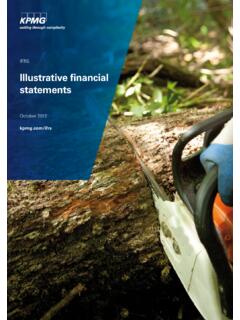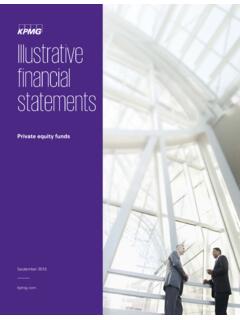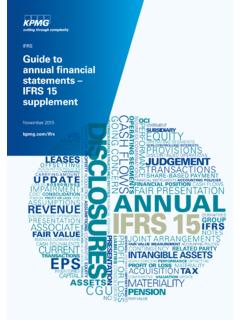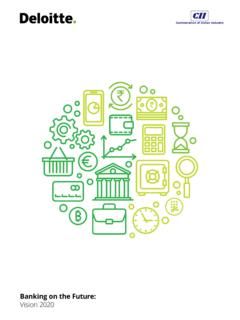Transcription of Emerging risks and evolving responses - KPMG
1 December 2018 Emerging risks and evolving the challenges facing banking and how the industry can respond2 Emerging risks and evolving responses 2018 KPMG LLP, a UK limited liability partnership and a member firm of the KPMG network of independent member firms affiliated with KPMG International Cooperative ( KPMG International ), a Swiss entity. All rights risks and evolving responses 2018 KPMG LLP, a UK limited liability partnership and a member firm of the KPMG network of independent member firms affiliated with KPMG International Cooperative ( KPMG International ), a Swiss entity. All rights summary41 Emerging risks62 evolving responses16 Conclusion: financial services fit for the Financial Developing evolving regulation and Building resilience28 Emerging risks and eveolving responsesTechnology heads the list of transformative forces in financial services. The shift from monolithic players toward ecosystems and the platform economy is creating a marketplace that is more interconnected and interdependent.
2 While this opens up opportunities for incumbents, new market entrants and customers alike, it also poses important questions about accountability and regulation especially as customer data becomes simultaneously more available and more valuable. Fast- evolving cybercrime also puts the market on its technology, social factors add challenges. Financial firms are expected to be more agile, transparent and trustworthy yet automation, while reducing costs, may rob them of vital knowledge and compel them to take direct responsibility for job losses. Fintech and big data could also distance firms from their customers at precisely the time they need to be closer to them. And although risk ratios have improved post-crisis, there are question marks over whether risk has just transferred back to the market and whether the trend towards passive investments will impact volatility. There are many potential stress events on the horizon and concerns over whether platform economies in finance could lead to greater concentration of risks and evolving responses 2018 KPMG LLP, a UK limited liability partnership and a member firm of the KPMG network of independent member firms affiliated with KPMG International Cooperative ( KPMG International ), a Swiss entity.
3 All rights summary What risks do banks face now and tomorrow and how can the industry respond? There was once a time when these questions might have felt easier to answer. Today, fast-changing technological, social and market developments make the landscape harder to read. In this report, we attempt to bring some clarity to the picture, looking at Emerging risks in depth and exploring some of the ways in which market participants and supervisors are responding. 5 Emerging risks and evolving responses 2018 KPMG LLP, a UK limited liability partnership and a member firm of the KPMG network of independent member firms affiliated with KPMG International Cooperative ( KPMG International ), a Swiss entity. All rights this complex, dynamic risk environment, there are signals that both market participants and regulators are evolving responses to confront and adapt to it. We are seeing banks build more agile, customer-focused operations that are overcoming the challenges of legacy technology with new software architectures.
4 There is a recognition that digital, data-driven propositions need to be at the heart of financial firms offers. There are likely to be moves towards partnerships as banks lose their advantage in distribution, and a focus on agility in production. By bringing together risk and finance in an integrated function, banks could access more actionable insights that improve agility is moving beyond its initial supportive response to fintech and actively looking to address the areas that fintech impacts: from platform economy risks to consumer protection, cross-border issues and acknowledgement that the regulatory perimeter is a dynamic concept that must be frequently reassessed. Supervisory Technology (SupTech) has the potential to make supervision more effective, and technology together with renewed processes has the potential to improve regulation around algorithmic , in recognition of the fact that things can go wrong no matter how many responses are in place, regulators and firms alike are looking to improve resilience so both firms and markets can bounce back more effectively from this complex, dynamic risk environment, there are signals that both market participants and regulators are evolving responses to confront and adapt to it.
5 6 Emerging risks and evolving responses 2018 KPMG LLP, a UK limited liability partnership and a member firm of the KPMG network of independent member firms affiliated with KPMG International Cooperative ( KPMG International ), a Swiss entity. All rights risksIntroductionThree key areas of risk confront financial firms and regulators today: Increasingly dependent on technology, markets are evolving into complex ecosystems that can become opaque at precisely the time that customers are demanding more transparency. Automation may have unintended consequences, placing social obligations on financial firms. And markets may present challenges around liquidity and a spectrum of stress stability7 Emerging risks and evolving responses 2018 KPMG LLP, a UK limited liability partnership and a member firm of the KPMG network of independent member firms affiliated with KPMG International Cooperative ( KPMG International ), a Swiss entity.
6 All rights reserved. TechnologyEcosystems and the platform economy 8 Customer data and regulation 10 The changing make-up of market participants 10 Cyber crime SocietalConduct risk 12 Automation, skills and employment 12 risks to consumers from fintech Financial stabilityLiquidity 14 Stress events 14 Fintech and technology 15 Emerging risks contents8 Emerging risks and evolving responses 2018 KPMG LLP, a UK limited liability partnership and a member firm of the KPMG network of independent member firms affiliated with KPMG International Cooperative ( KPMG International ), a Swiss entity. All rights TechnologyThere s no question that in recent years, financial markets have become more reliant on technology. They are more interconnected, and more interdependent. Banks now depend on a complex ecosystem of infrastructure from cloud services, exchanges and platforms to valuation and data providers, and retail payment systems.
7 All of this is now critical infrastructure but much of it is outside the banks own control and beyond the regulator s scrutiny. As it is more integrated, this ecosystem creates more weak spots for cyberattacks. In its July 2018 discussion paper Building the UK financial sector s operational resilience1, the Bank of England and PRA identified five technology-related challenges created by today s context of technological complexity and hostile cyber environment:Ecosystems and the platform economy1 innovations that change the nature of payment systems and markets: fintech, artificial intelligence, distributed ledger technology and crypto behaviours, in which consumers of financial services respond to innovation and interact with financial services differently, demanding instant and mobile access, and faster pace: the need to plug skills gaps and manage obsolescence in the face of rapid technical change (see page 12).
8 Challenging environment: an increase in the frequency and sophistication of cyber threats and financial crime (see page 11) and cost pressures in response to competition from disruptive market complexity, in particular the proliferation of third parties, the potential for concentration risk and cross-border risks and evolving responses 2018 KPMG LLP, a UK limited liability partnership and a member firm of the KPMG network of independent member firms affiliated with KPMG International Cooperative ( KPMG International ), a Swiss entity. All rights management needs to account for this and accept that as technological third parties becomes more interdependent, failure is is for this reason that the PRA and FCA are consulting widely on the subject of operational resilience. This starts from the point that failure is inevitable and that what matters is how financial institutions prepare and react.
9 In spring 2018, during the difficulties caused by its system upgrade, TSB became a target for cybercriminals, with a spike in phishing attacks targeting the bank s customers2. This illustrates the need for a resilience approach that not only prepares for the consequences of system failure itself, but also takes into account the potential knock-on effects that such an outage can cause. So risk management and operations functions at banks have to assess and mitigate their own risk in the context of a financial system that is more intrinsically linked than ever. Most importantly, banks own operational resilience depends on their ability to assess the resilience of the many third-party service providers on which they depend. On page 16 we look in more depth at the steps banks can take to build resilience in this : should markets or regulators drive it?This complex ecosystem lacks transparency and its interconnectedness could lead to consequences we don t yet understand.
10 How do we get more transparency and assurance? Should this come from regulation? It may not be necessary for much of it exchanges, for example, are already tightly regulated but it may be inevitable for some. The markets are already demanding greater transparency, and we are seeing more assurance proactively provided to the market . In other cases, regulation is starting to draw in new businesses, for example in the benchmarks space, where benchmark administrators, contributors and users are impacted by the regulatory requirements. It may make sense to see regulation as a spectrum from tight, formal regulation at one end to management by market forces at the other, depending on how critical the technology or data is. Transparency is ecosystems are complex. Where do responsibilities lie? Interconnectedness is speeding up as financial services become platform-based and open banking creates new possibilities.














